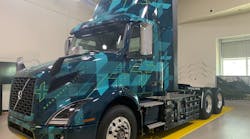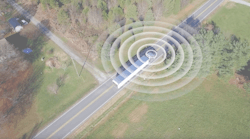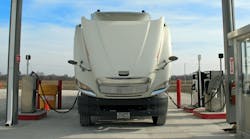Our industry is not slowing down. Technology continues to advance the capabilities, functionality, and safety of trucks on the road today. As we roll into a new decade next month, I’ve found it’s been helpful to reflect on the past to understand what got us where we are today, and to better understand where our industry may be headed.
As it relates to future technologies, I hear three topics repeatedly mentioned: connectivity, automation, and electromobility.
We’ve heard about the bigger picture for some time – fully autonomous, all-electric trucks, having the ability to communicate with other vehicles and the surrounding infrastructure, are a possibility in the not-too-distant future. But, how does that more directly relate to you and your day-to-day operations?
Maintenance is just one piece of the interconnected web that is the commercial vehicle industry. Proper maintenance and service drives vehicle uptime. When I’m talking to industry colleagues, I explain the importance of knowing about all of the web’s working parts, and stress that understanding the sum of these parts helps to better recognize the impact other industry changes may have on maintenance operations.
So, let’s dive in and discuss how these industry trends have started and will continue to influence commercial vehicle service and maintenance.
Data and connectivity
With the advent of digital and cloud-based storage, fleets have been able to collect so much information from the vehicle and operations, such as trip data from management and maintenance systems, onboard vehicle sensors and systems, and telematics devices – it can seem overwhelming. Virtually anything can be considered data – it could be the vehicle speed, interval of a service, or a part number. All of those pieces of information separately won’t help a fleet accomplish anything.
It’s been the shift to utilizing this data that has driven more drastic change. Advancements in the collection, assessment, and presentation of this information to fleets in order to best utilize and provide direction on decision-making for the business have driven operational improvements.
Companies continue to find new methods and areas from which to collect data, too. For instance, when it comes to data from vehicle assets, until relatively recently the tractor had been the primary focus. A more recent trend has been the development of “smart” trailers. Trailer technology has evolved to where sensors collect data from all aspects of the unit to help monitor items such as tire pressure (with the ability to adjust inflation of each tire based on load), asset location, cameras to monitor payload in trailers, etc.
How will data and connectivity continue to affect vehicle maintenance? In particular, we’ll see continued progress in better optimizing vehicle service through predictive maintenance practices and benchmarking programs, uptime efficiencies through remote diagnostics and remote programming, and improved optimization of parts ordering and stocking.
Predictive maintenance and benchmarking
The model of “service-before-failure” has been more widely adopted with the advent of the data collected being turned into usable information. Tracking and comparing data on unplanned breakdowns can help improve an entire maintenance operation and lower maintenance costs.
Benchmarking, a process used to monitor and compare the performance of a process or system, is a method that requires the use of accurate and thorough data sets in a standardized format in order to create actionable items. It provides fleets a means to set a standard and measure the operation’s failure or success against that standard.
Remote diagnostics and programming
In the world of telematics and connected vehicles, the ability to remotely diagnose and program a vehicle will have a profound impact on vehicle uptime. I hate using the term "game changer," but … here we are, and remote vehicle management will be just that.
This means a fleet can receive notifications on a potential vehicle issue, sometimes before the driver is even aware, and proactively communicate with the driver and schedule service at the nearest service location – the bay open and parts ready when the truck arrives.
Contributing editor Gregg Wartgow covers this topic extensively in his feature "Remote vehicle management enters a new phase."
Improved parts distribution
Data collection and connectivity will continue to push for more breadth and less depth of coverage for stocking replacement parts. That’s because in the world of Amazon and expedited shipping, more overnight and same-day parts deliveries will become the norm. Trends in online parts ordering will continue as ecommerce platforms become more functional with real-time inventory updates and integration to fleet management and maintenance systems. All of these changes will lead to a shift where predictive parts ordering will allow a fleet to automatically receive parts as needed for the anticipated service of trucks entering the shop.
Automation
When it comes to a monumental shift (pun intended) in a relatively short amount of time, no vehicle system specification change in recent memory has been so accelerated as the adoption of automated manual transmissions (AMTs).
According to Mike Roeth, executive director for NACFE, AMTs have seen an enormous increase in adoption rates – from approximately 10 percent in 2013 to more than 90 percent in 2018. He suggests there are a few reasons fleets have continued to gravitate toward AMTs: it has helped attract and retain drivers, has provided fuel savings, and has helped to improve maintenance costs and residual value.
As it relates to automation, active safety systems continue to improve vehicle safety while assisting as the driving force behind the development of automated vehicles. Coupled with data collected from the vehicle and the ability for software development to utilize artificial intelligence through machine learning and other predictive measures, we’ll continue to see advancements here. Check out t"How active safety systems pave the way to vehicle autonomy" for more.
Electrification
When you hear “electrification” you probably first think about a full-electric truck. That’s certainly being discussed in the industry today, but there are incremental changes to individual electric component and system designs that will help lead the way, and will more directly impact maintenance sooner than later.
There are certain use cases where fully electric trucks can and will work. So far, we’ve seen that primarily for buses and terminal or port operations, with dedicated routes and stop-and-go traffic where regenerative braking can extend battery life and save brakes. With the exception of these specific applications, diesel engines will continue to be the primary method of powering commercial vehicles for the foreseeable future.
That hasn’t stopped power management suppliers, like Eaton and Dana, from continuing to push development on electrified components such as 48V systems and eAxles, respectively. Some of these systems will help supplement traditional powertrains to not only improve fuel economy, but to reduce wear and tear on vehicles and their components, and to plan for the possibility of more extensive electrification system adoption.
What’s next?
While many of the trends above have been covered in the pages of Fleet Maintenance, we’ve only scratched the surface. I haven’t even mentioned items such as challenges with staffing shortages from drivers to technicians, or improvements to engine efficiency and performance to meet ever-stringent federal emissions regulations.
We’ll continue to bring you critical information throughout 2020 and beyond, as we evaluate and share how changes to vehicles and operations will impact your business.





